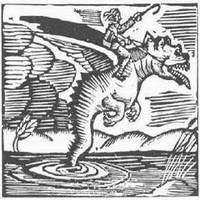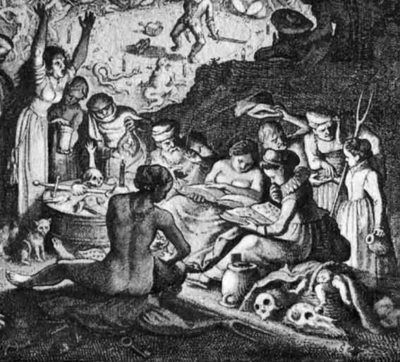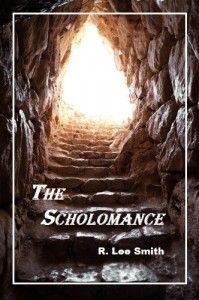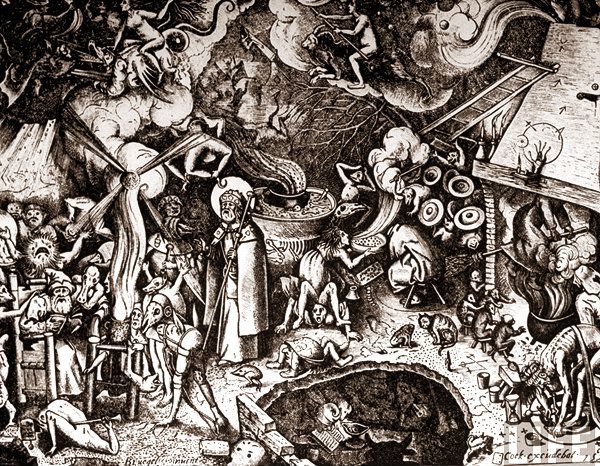Scholomance
„Şi-o trecut solomonaru’
Care umblă cu şercanu’ (balaurul)
Din zbici o pocnitu
Pe iel s-o suitu
Şi s-o tot rotitu
Ploaia s-o pornitu.”
(Romanian folklore)

The Scholomance is a legendary school of magic run by the Devil himself in the Romanian mythology. It`s location supposed to be near a lake in the Carpathians (the mountains south of the city of "Hermannstadt" or Sibiu, as it was called by Romanian inhabitants) in the famous already Romanian land of Transylvania. The place is mentioned twice in the novel Dracula by Bram Stoker:
"The Draculas were, says Arminius, a great and noble race, though now and again were scions who were held by their coevals to have had dealings with the Evil One. They learned his secrets in the Scholomance, amongst the mountains over Lake Hermanstadt, where the devil claims the tenth scholar as his due."(Chapter 18)
"He dared even to attend the Scholomance, and there was no branch of knowledge of his time that he did not essay."(Chapter 23)
The source

The form of the name Scholomance appears transcribed as it is in the work of a Scottish lady-author:
Emily Gerard. She was the wife of a Polish noble and cavalryman and he was stationed in Romania. Emily Gerard joined him in Hermanstadt (Sibiu) and found the archaic superstitions of the zone very surprising and even primitive.She used the time spent there to give detailed description of the folklore in her article "Transylvanian Superstitions". This is a quote of the article that was published in the English monthly literary magazine
"The Nineteenth Century"(1885, page 136):
"As I am on the subject of thunderstorms, I may as well here mention the Scholomance, or school supposed to exist somewhere in the heart of the mountains, and where all the secrets of nature, the language of animals, and all imaginable magic spells and charms are taught by the devil in person. Only ten scholars are admitted at a time, and when the course of learning has expired and nine of them are released to return to their homes, the tenth scholar is detained by the devil as payment, and mounted upon an Ismeju (dragon) he becomes henceforward the devil's aide-de-camp, and assists him in 'making the weather,' that is, in preparing thunderbolts. A small lake, immeasurably deep, lying high up among the mountains south of Hermanstadt, is supposed to be the cauldron where is brewed the thunder, and in fair weather the dragon sleeps beneath the waters."

The forms of the words "Scholomance" and "Ismeju" are different from how are they transcribed today in Romanian (Solomonarie - with the variant Solomanta - and Zmeu) and is obvious that, unfamiliar as she was with the Romanian language, she tried to transcribed the words as she heard them. However the information is genuine and based on very old traditions, maybe of pre-Christian but with some imported Christian traits.
The scholars of this school are associated with real persons known in Romanian folklore as
Solomonari.
In literature

Stoker was inspired by the book of Emily Gerard and extended the name of the city Hermanstadt over the legendary lake from the area, as in reality there is no such a lake. The lakes who could be bound by Emily Gerard`s article, as Solomonari`s lake could be either Paltinis or Balea Lake.
There are at least two more novels that mention Scholomance:
- "Lord of Middle Air" by Michael Scott Rohan
"In the book Lord of Middle Air by Michael Scott Rohan, the wizard Michael Scot reveals that he dared to train at the Scholomance on two occasions, as there was so much knowledge it could not all be learned in one night."
- "The Scholomance" by R. Lee Smith
"For centuries, there has been a legend of a hidden school where magic is taught by the demons who dwell there to anyone who seeks them out, but they ask a terrible price: Anyone who reaches the door of the Scholomance may enter, but the Devil takes every tenth student who tries to leave. A hidden school. Demonic masters. An inescapable fate for one out of every ten graduates. But Connie would do anything to have the magic her best friend was born with."
Solomonarii

Solomonari (sing.Solomonar) was the generic term used by Romanians (Vallachians) for the peasant-magician who were once wondering through their villages. They were also named grindinari, hultani, ghetari or zgrabuntasi.
In the Romanian folklore they could indeed master the storms by creating and taming the water-dragons that lived in the mountain lakes. They carry usually a strange book (that contains all their magical knowledge and spells), an axe (that could change the weather once it`s plunged in wood or in the threshold or that could release the dragon from the frozen lake), a small semantron (that could be used to invoke the spirits of the wind, Vantoasele) and other rather shamanic artifacts such as "moime".
They are considered sometimes bad or good in nature (even Godly people rather then malefic servants of the dark forces) and many consider them as good magicians since they could bring the rains in the arid areas. It`s possibly that the Christian religion that influenced them to be the one who put the stigmata of evil on them the same as it happened with the
benandanti in Italy.
Katherine Ramsland (doctor in forensic psychology, clinical psychology, and philosophy and teacher at DeSales University) describes them as: "tall, redheaded men clad in white wool...[with] several instruments of magic and a book of instruction." They are "trained for nine years...overcoming obstacles and surviving ordeals. Their final examination involved copying all that they knew about humanity into the Solomonar's book."
The name comes probably from Bible`s King Solomon, but the fabulous association with the dragon may have pre-christian origins, some would trace it to the ancient Dacian civilization that held the dragon as one of their main religious emblems. In ancient Dacia some of the priests of the old religion(s) were named
Kapnobatai and this may be translated as "the ones who walk/climb on the clouds" and this habit of walking the clouds is sticking similar with the habit of the solomonari of riding the water-dragons hidden in the clouds. Just as kapnobatai, solomonari are abstinent and doesn`t eat meat.
One of the main powers of the solomonari was to see the major events from the future.

- Gerard, Emily. TRANSYLVANIAN SUPERSTITIONS, The Nineteenth Century, 1885, p. 128-144
- Bram Stoker, DRACULA, 1897
- Ioan G. Coman, L'IMMORTALITÉ
CHEZ LES THRACO-GÉTO-DACES.
- Iulia Gorneanu , POVESTI CU SOLOMONARI, Jurnalul National, 25 september 2011
- the main site dedicated to solomonari (in Romanian): Tara Solomonarilor www.solomonarii.uv.ro/












COMMENTS
-